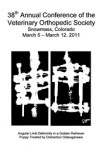Objective: To evaluate whether femoral head diameter and head-to-neck ratio (HNR) influence prosthetic impingement-free motion (IFM) in canine total hip replacement (THR) using a press-fit cementless hip system in silico.
Methods: This was a descriptive study conducted from January through June 2025. Twenty-eight head-neck combinations were assembled using 3-D stereolithographic files of cementless THR implants (Universal Hip System; BioMedtrix). For each implant combination, IFM was evaluated using a custom-built computer simulation software program around 3 orthogonal axes: abduction-adduction, flexion-extension, and internal-external rotation. Impingement-free motion was also evaluated in 3-D, characterized as the envelope where the femoral neck axis has IFM. Head diameter, neck diameter, and HNR were calculated, and their effects on IFM were analyzed.
Results: Larger femoral head diameters were associated with increased IFM in all directions. Each increase in head size corresponded to a 16% to 33% gain in IFM. The presence of a head collar reduced 3-D IFM by 10% to 36%. The IFM loss was larger for smaller head sizes. Higher HNRs were strongly and positively associated with 3-D IFM. The IFM in internal and external rotation occurred beyond estimated physiologic hip motion when HNR was larger than 1.6.
Conclusions: Femoral head size and HNR are key determinants of IFM in the simulated canine THR model. The use of larger heads without collars improves prosthetic mobility and may reduce in vivo prosthetic impingement.
Clinical relevance: The risk of postoperative prosthetic luxation in canine THR may be reduced through proper implant selection and maximizing IFM.









